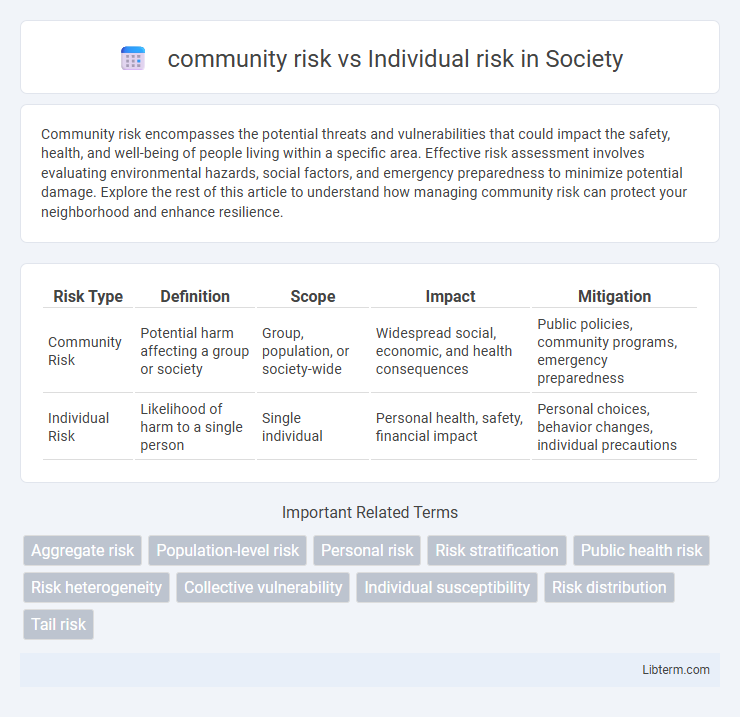Community risk encompasses the potential threats and vulnerabilities that could impact the safety, health, and well-being of people living within a specific area. Effective risk assessment involves evaluating environmental hazards, social factors, and emergency preparedness to minimize potential damage. Explore the rest of this article to understand how managing community risk can protect your neighborhood and enhance resilience.
Table of Comparison
| Risk Type | Definition | Scope | Impact | Mitigation |
|---|---|---|---|---|
| Community Risk | Potential harm affecting a group or society | Group, population, or society-wide | Widespread social, economic, and health consequences | Public policies, community programs, emergency preparedness |
| Individual Risk | Likelihood of harm to a single person | Single individual | Personal health, safety, financial impact | Personal choices, behavior changes, individual precautions |
Understanding Community Risk vs Individual Risk
Community risk refers to the potential for harm or adverse outcomes affecting a group or population due to shared environmental, social, or economic factors, while individual risk focuses on the likelihood of a single person experiencing harm based on personal behaviors, genetics, and lifestyle. Understanding community risk involves analyzing patterns, exposure levels, and mitigation strategies across populations to implement public health interventions effectively. Individual risk assessment requires personalized evaluation of factors such as medical history and habits to tailor prevention and treatment plans.
Key Differences Between Community and Individual Risk
Community risk refers to potential hazards that affect a group or population within a specific area, encompassing factors such as environmental threats, public health issues, and socio-economic vulnerabilities. Individual risk focuses on the likelihood of harm or loss experienced by a single person, influenced by personal behaviors, genetics, and immediate surroundings. Key differences lie in the scale of impact, assessment methods--aggregate data for communities versus personalized analysis for individuals--and the strategies employed for risk mitigation, which range from public policies to tailored preventive measures.
The Role of Public Health in Managing Community Risk
Public health plays a crucial role in managing community risk by implementing strategies that reduce the spread of infectious diseases and mitigate environmental hazards affecting large populations. Surveillance systems, vaccination programs, and health education campaigns focus on minimizing risk factors that impact collective health outcomes rather than isolated individual cases. These efforts enhance community resilience, protect vulnerable groups, and optimize resource allocation during public health emergencies.
How Individual Choices Impact Community Safety
Individual risk choices directly influence community safety by altering exposure to hazards and transmission of diseases. For example, personal decisions regarding vaccination, mask-wearing, and social distancing significantly affect the spread of infectious diseases within a population. By adopting responsible behaviors, individuals reduce overall community risk, demonstrating the critical link between personal actions and public health outcomes.
Case Studies: Community Risk in Action
Case studies like the Flint water crisis reveal how community risk manifests through environmental hazards disproportionately affecting vulnerable populations, leading to widespread health issues and long-term socio-economic impacts. Analysis of the COVID-19 pandemic demonstrates community risk propagation, where high-density urban areas experienced rapid virus transmission, overwhelming healthcare systems and exacerbating inequalities. These cases highlight the importance of targeted public health policies and infrastructure investment to mitigate collective risk and protect community well-being.
Individual Risk Perception and Decision-Making
Individual risk perception significantly influences personal decision-making by shaping how people assess hazards and probabilities of adverse outcomes. Cognitive biases, emotional responses, and subjective interpretation cause disparities between actual statistical risks and perceived personal risks. Understanding these psychological factors is crucial for designing effective communication strategies that promote safer behaviors in high-risk environments.
Policy Approaches: Balancing Individual and Collective Safety
Policy approaches to community risk versus individual risk emphasize the need to harmonize public safety measures with personal freedoms. Effective strategies integrate data-driven risk assessments and targeted interventions that consider population health metrics while protecting individual rights. Regulatory frameworks and public engagement ensure policies address collective safety without disproportionately infringing on personal autonomy.
Ethical Considerations in Risk Management
Community risk versus individual risk in ethical risk management involves balancing collective safety with personal autonomy, ensuring that protective measures do not disproportionately infringe on individual rights. Ethical considerations demand transparent communication, equitable resource distribution, and respect for diverse values within the community when implementing risk mitigation strategies. Prioritizing both societal welfare and individual dignity fosters trust and promotes informed decision-making in risk management policies.
Communication Strategies for Addressing Risk at Both Levels
Effective communication strategies for addressing community risk emphasize inclusive messaging, broad stakeholder engagement, and transparent information sharing to foster collective awareness and preparedness. Individual risk communication prioritizes personalized, clear, and actionable information tailored to specific demographics and behaviors to motivate protective actions. Leveraging digital platforms, local media, and trusted community leaders enhances message reach and impact across both community and individual levels.
Future Directions in Community and Individual Risk Assessment
Future directions in community and individual risk assessment emphasize integrating real-time data analytics and machine learning to enhance predictive accuracy for diverse populations. Advances in geospatial technologies and social determinants of health will facilitate more precise identification of vulnerable groups and targeted interventions. Collaboration between public health agencies and technology developers is critical to developing scalable, dynamic models that adapt to emerging hazards and evolving demographic patterns.
community risk Infographic

 libterm.com
libterm.com